Novomessor cockerelli Ants and Lycaenid Caterpillar
Watching Novomessor cockerelli Ants carrying their "pet" caterpillar. Very cool.
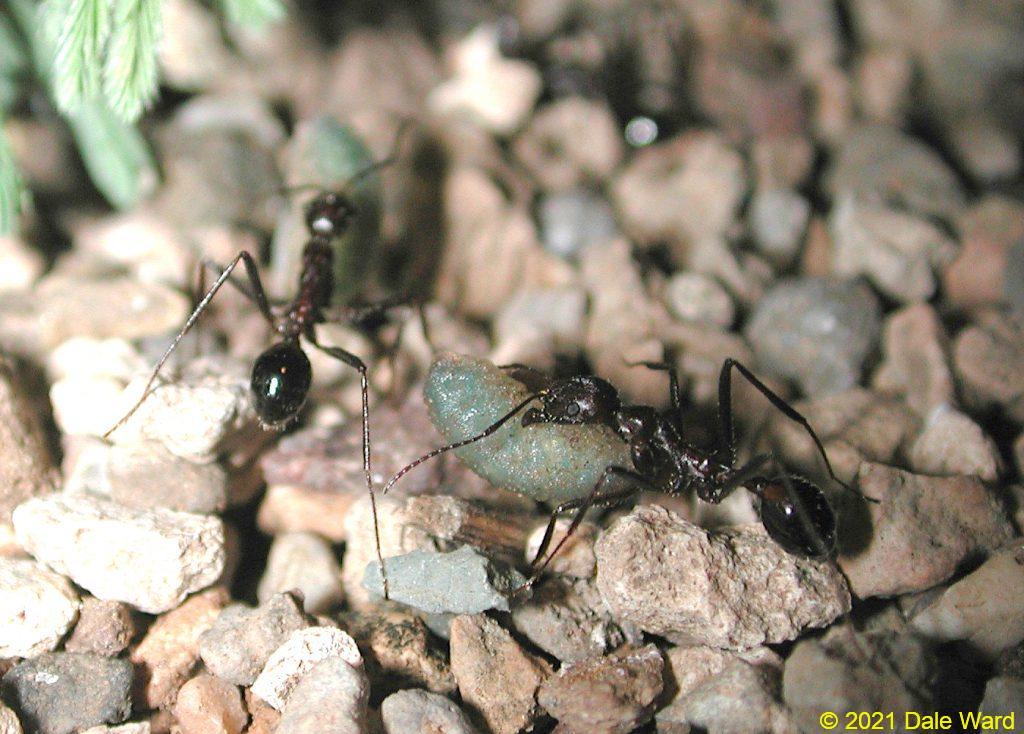 Two _Novomessor cockerelli_ workers, each carrying caterpillars.
Two _Novomessor cockerelli_ workers, each carrying caterpillars.
In August of 2002, I was camping in the foothills of Arizona’s Whetstone Mountains. I had just gotten a Nikon Coolpix camera, and a screw-on magnifying glass that was acting as a makeshift macro lens. I was walking through the nighttime desert with a flashlight, looking for things to photograph.
As I walked by a Novomessor cockerelli nest, I saw that a a lot of the workers were clustered near the nest entrance, milling around.
There were some smaller Dorymyrmex insanus ants that were mixed with the Novomessor workers. The Dorymyrmex didn’t seem to be attacking the Novomessor, but the Novomessor were upset with the Dorymyrmex.
The Dorymyrmex would make occasional attempts to walk into the Novomessor nest, almost casually. The Novomessor workers would lunge at the Dorymyrmex.
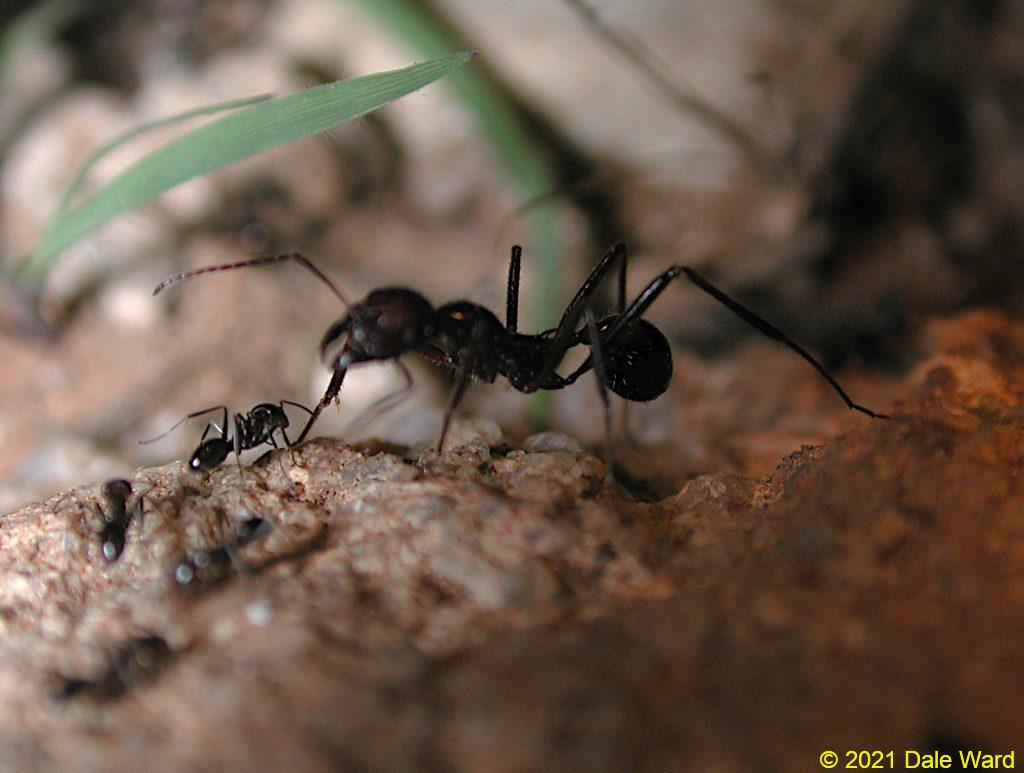 _Novomessor cockerelli_ (large ant in center of photo) facing _Dorymyrmex insanus_ (small ants in lower left corner of photo). The _Dorymyrmex_ were making periodic attempts to enter the _Novomessor_ nest.
_Novomessor cockerelli_ (large ant in center of photo) facing _Dorymyrmex insanus_ (small ants in lower left corner of photo). The _Dorymyrmex_ were making periodic attempts to enter the _Novomessor_ nest.
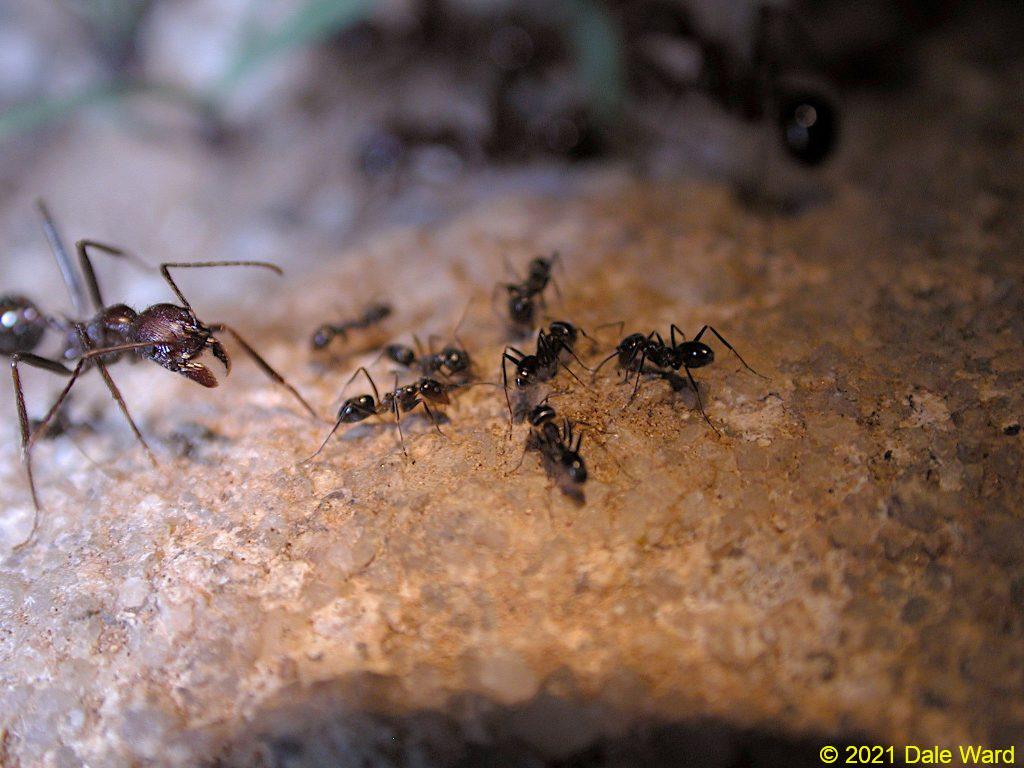 Group of _Dorymyrmex insanus_ (center of photo) with _Novomessor cockerelli_ worker (larger ant on left of photo). The _Novomessor_ was guarding the nest, would periodically lunge at the _Dorymyrmex._ Note that the _Dorymyrmex_ aren’t paying much attention to the _Novomessor._
Group of _Dorymyrmex insanus_ (center of photo) with _Novomessor cockerelli_ worker (larger ant on left of photo). The _Novomessor_ was guarding the nest, would periodically lunge at the _Dorymyrmex._ Note that the _Dorymyrmex_ aren’t paying much attention to the _Novomessor._
Watching the Dorymyrmex and the Novomessor spar was fascinating, but what I saw next was really cool. At least two of the Novomessor ants were carrying sparkling blue-green bundles. What on earth…? The bundles appeared to be some sort of larvae.
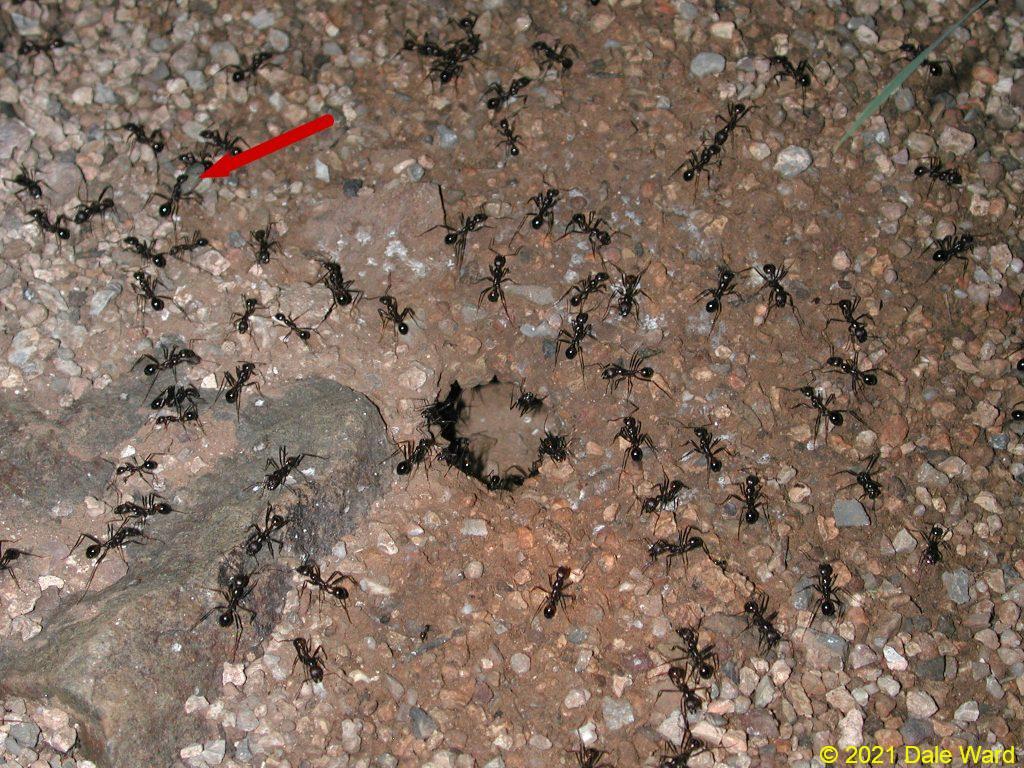 Entrance of the _Novomessor cockerelli_ nest. Red arrow points to worker carrying one of the blue-green larva.
Entrance of the _Novomessor cockerelli_ nest. Red arrow points to worker carrying one of the blue-green larva.
As I looked more closely, I thought that the bundles looked like some sort of caterpillar. The color of the bundles, the segmentation, the bagginess, all suggested ‘caterpillar’. The ants didn’t seem to be going anywhere with the caterpillars - they were just wandering around near the nest entrance.
 Two _Novomessor cockerelli_ workers, each carrying caterpillars.
Two _Novomessor cockerelli_ workers, each carrying caterpillars.
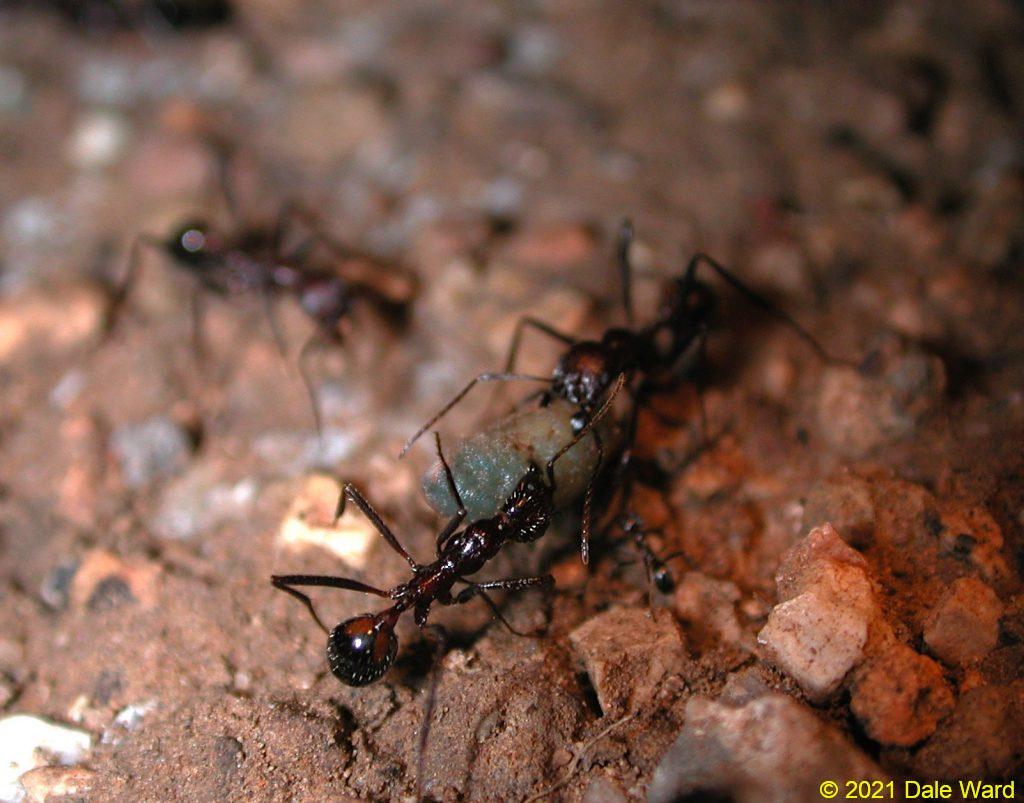 _Novomessor cockerelli_ workers with the larva. You can see a small _Dorymyrmex insanus_ just to the right of the larva, between the two _Novomessor_ workers.
_Novomessor cockerelli_ workers with the larva. You can see a small _Dorymyrmex insanus_ just to the right of the larva, between the two _Novomessor_ workers.
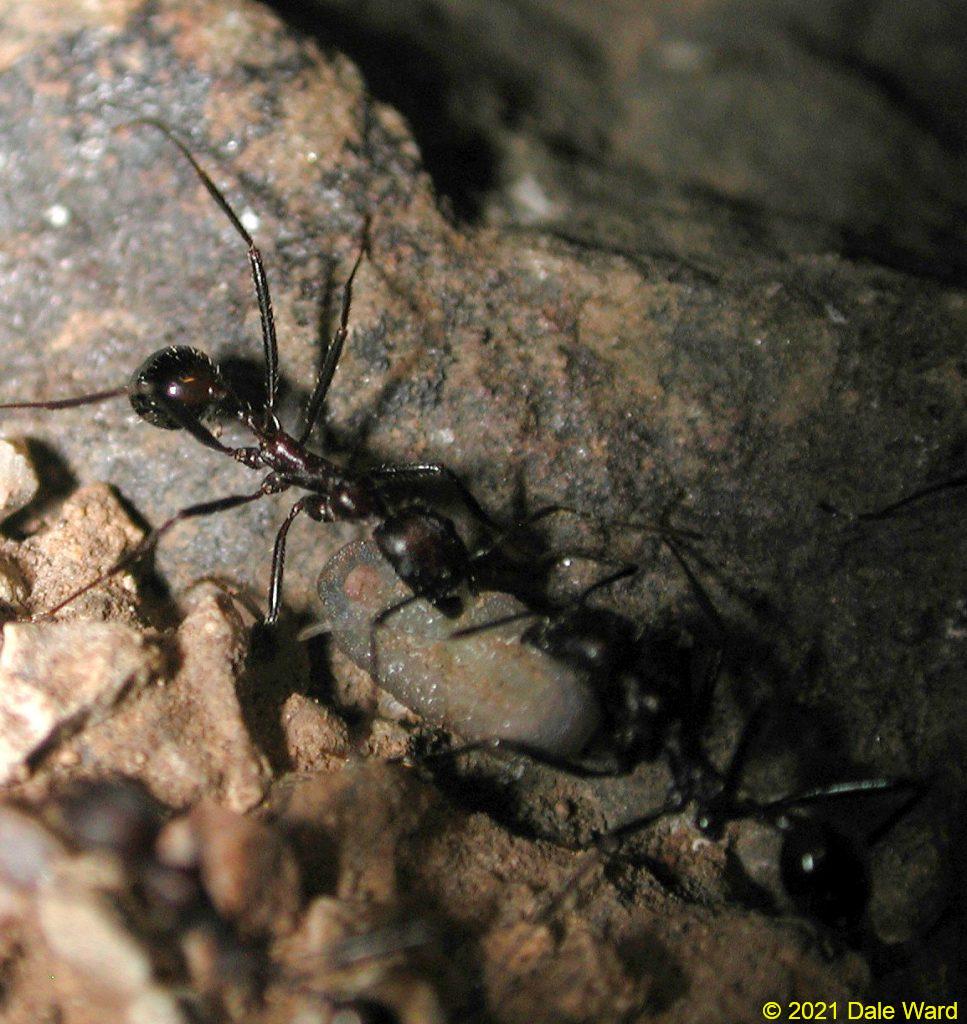 _Novomessor cockerelli_ workers carrying the larva. In this photo, you can see the blue-green color that larva had originally, as well as the larva’s sparkly appearance. We’re looking at the ventral side of the larva here, it’s head is the tan dot on the left end of the larva.
_Novomessor cockerelli_ workers carrying the larva. In this photo, you can see the blue-green color that larva had originally, as well as the larva’s sparkly appearance. We’re looking at the ventral side of the larva here, it’s head is the tan dot on the left end of the larva.
The caterpillars’ bodies were held in a mild C-shape, curved around their bellies. I didn’t see them move their bodies at all. The curve to their bodies and their passivity made them look a lot like pre-pupal caterpillars that I’ve seen.
Sometimes another ant would approach the ant that was carrying a caterpillar and try to carry the caterpillar as well. They didn’t seem to fight over the caterpillars, and they also didn’t pull hard enough to damage the caterpillars.
I noticed one of the caterpillars had what looked to be a droplet of fluid on its tail end (see photo below).
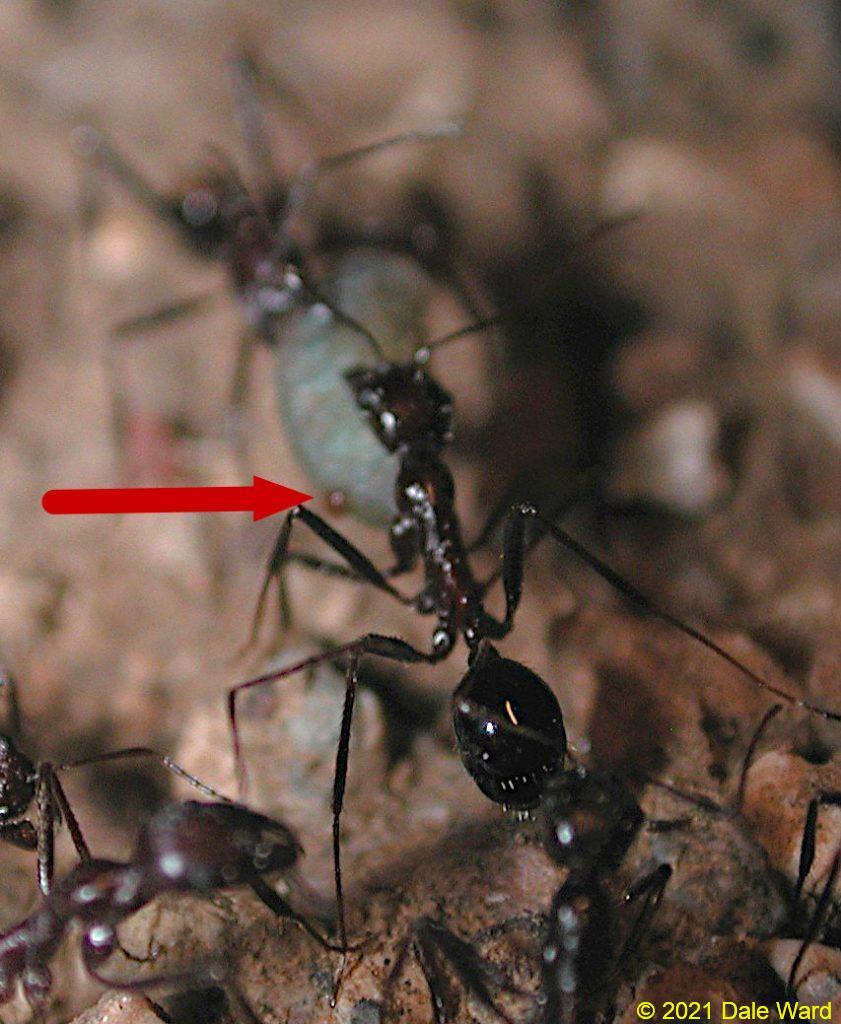 _Novomessor cockerelli_ workers carrying larva. Arrow points to location on larva that might be exudate from the dorsal nectary organ of the larva.
_Novomessor cockerelli_ workers carrying larva. Arrow points to location on larva that might be exudate from the dorsal nectary organ of the larva.
I popped one of the caterpillars into an alcohol vial so that I could have a better look at it in the daytime.
After I returned home, I found that caterpillar-ant associations are common. It turns out that some caterpillars ‘bribe’ ants into looking after them, protecting them from predators and parasitoids. These caterpill— title: Novomessor cockerelli Ants and Lycaenid Caterpillar date: 2021-01-09 categories: [ant, insects, mothsandbutterflies] tags: [ant, butterfliesandmoths, insect, myrmecophile] image: images/DSCN9366.jpg description: —
 Two _Novomessor cockerelli_ workers, each carrying caterpillars.
Two _Novomessor cockerelli_ workers, each carrying caterpillars.
In August of 2002, I was camping in the foothills of Arizona’s Whetstone Mountains. I had just gotten a Nikon Coolpix camera, and a screw-on magnifying glass that was acting as a makeshift macro lens. I was walking through the nighttime desert with a flashlight, looking for things to photograph.
As I walked by a Novomessor cockerelli nest, I saw that a a lot of the workers were clustered near the nest entrance, milling around.
There were some smaller Dorymyrmex insanus ants that were mixed with the Novomessor workers. The Dorymyrmex didn’t seem to be attacking the Novomessor, but the Novomessor were upset with the Dorymyrmex.
The Dorymyrmex would make occasional attempts to walk into the Novomessor nest, almost casually. The Novomessor workers would lunge at the Dorymyrmex.
 _Novomessor cockerelli_ (large ant in center of photo) facing _Dorymyrmex insanus_ (small ants in lower left corner of photo). The _Dorymyrmex_ were making periodic attempts to enter the _Novomessor_ nest.
_Novomessor cockerelli_ (large ant in center of photo) facing _Dorymyrmex insanus_ (small ants in lower left corner of photo). The _Dorymyrmex_ were making periodic attempts to enter the _Novomessor_ nest.
 Group of _Dorymyrmex insanus_ (center of photo) with _Novomessor cockerelli_ worker (larger ant on left of photo). The _Novomessor_ was guarding the nest, would periodically lunge at the _Dorymyrmex._ Note that the _Dorymyrmex_ aren’t paying much attention to the _Novomessor._
Group of _Dorymyrmex insanus_ (center of photo) with _Novomessor cockerelli_ worker (larger ant on left of photo). The _Novomessor_ was guarding the nest, would periodically lunge at the _Dorymyrmex._ Note that the _Dorymyrmex_ aren’t paying much attention to the _Novomessor._
Watching the Dorymyrmex and the Novomessor spar was fascinating, but what I saw next was really cool. At least two of the Novomessor ants were carrying sparkling blue-green bundles. What on earth…? The bundles appeared to be some sort of larvae.
 Entrance of the _Novomessor cockerelli_ nest. Red arrow points to worker carrying one of the blue-green larva.
Entrance of the _Novomessor cockerelli_ nest. Red arrow points to worker carrying one of the blue-green larva.
As I looked more closely, I thought that the bundles looked like some sort of caterpillar. The color of the bundles, the segmentation, the bagginess, all suggested ‘caterpillar’. The ants didn’t seem to be going anywhere with the caterpillars - they were just wandering around near the nest entrance.
 Two _Novomessor cockerelli_ workers, each carrying caterpillars.
Two _Novomessor cockerelli_ workers, each carrying caterpillars.
 _Novomessor cockerelli_ workers with the larva. You can see a small _Dorymyrmex insanus_ just to the right of the larva, between the two _Novomessor_ workers.
_Novomessor cockerelli_ workers with the larva. You can see a small _Dorymyrmex insanus_ just to the right of the larva, between the two _Novomessor_ workers.
 _Novomessor cockerelli_ workers carrying the larva. In this photo, you can see the blue-green color that larva had originally, as well as the larva’s sparkly appearance. We’re looking at the ventral side of the larva here, it’s head is the tan dot on the left end of the larva.
_Novomessor cockerelli_ workers carrying the larva. In this photo, you can see the blue-green color that larva had originally, as well as the larva’s sparkly appearance. We’re looking at the ventral side of the larva here, it’s head is the tan dot on the left end of the larva.
The caterpillars’ bodies were held in a mild C-shape, curved around their bellies. I didn’t see them move their bodies at all. The curve to their bodies and their passivity made them look a lot like pre-pupal caterpillars that I’ve seen.
Sometimes another ant would approach the ant that was carrying a caterpillar and try to carry the caterpillar as well. They didn’t seem to fight over the caterpillars, and they also didn’t pull hard enough to damage the caterpillars.
I noticed one of the caterpillars had what looked to be a droplet of fluid on its tail end (see photo below).
 _Novomessor cockerelli_ workers carrying larva. Arrow points to location on larva that might be exudate from the dorsal nectary organ of the larva.
_Novomessor cockerelli_ workers carrying larva. Arrow points to location on larva that might be exudate from the dorsal nectary organ of the larva.
I popped one of the caterpillars into an alcohol vial so that I could have a better look at it in the daytime.
After I returned home, I found that caterpillar-ant associations are common. It turns out that some caterpillars ‘bribe’ ants into looking after them, protecting them from predators and parasitoids. These caterpillars will often have a dorsal nectary gland (“Newcomer’s Gland”) on them that secretes a sugary substance for the ants.
I wondered if that’s what the droplet on the caterpillar in my photo was…a secretion from Newcomer’s Gland. I’d have expected the secretion to be clear, though - so perhaps the droplet of liquid was something else.
I put my preserved caterpillar under the microscope so that I could get a better look at it. Unfortunately, the caterpillar had lost its beautiful sparkly green-blue coloration after death.
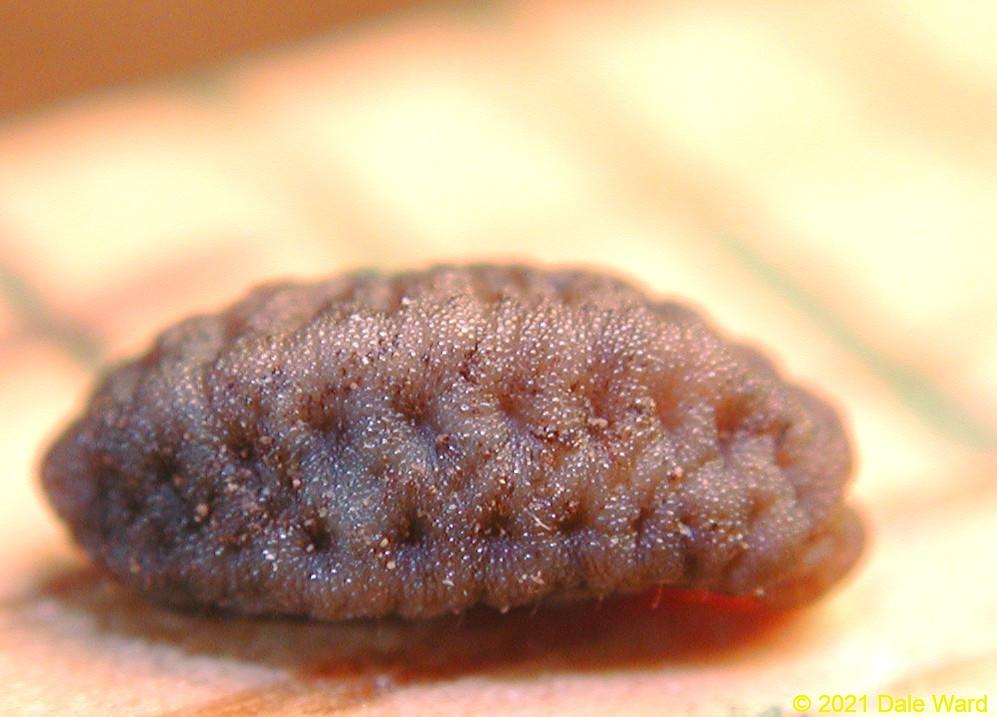 Dorsal view of caterpillar (face is down). Photograph of preserved specimen in the lab.
Dorsal view of caterpillar (face is down). Photograph of preserved specimen in the lab.
The skin of the caterpillar was tough and wrinkled, like the skin of a tiny elephant. That makes sense if one makes a habit of being carried around around in the mandibles of ants, I supposed.
I could see that the head of the caterpillar was surrounded by a collar of thick skin, like a leathery turtle-neck. The caterpillar’s body seemed to have a slight dorso-ventral curve to it, so that its head did not stick out on the front like a marshmallow on a stick, as do the heads of most caterpillars. Its face would be mostly inaccessible to the ants if the caterpillar were on a branch because of the collar and the caterpillar’s head posture.
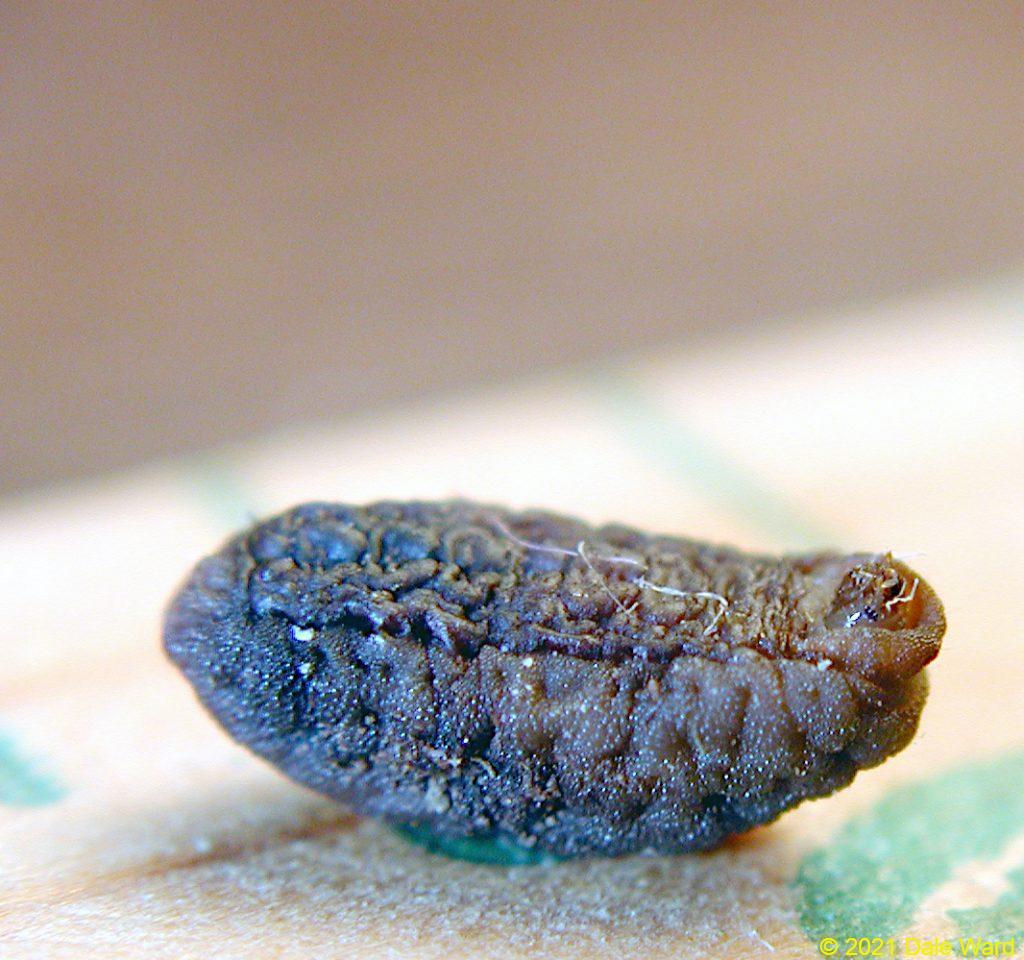 Photographic of a caterpillar back at the lab. Head is on the right-hand side of the photo, caterpillar is on its back. The caterpillar has lost its bluish-green color.
Photographic of a caterpillar back at the lab. Head is on the right-hand side of the photo, caterpillar is on its back. The caterpillar has lost its bluish-green color.
The caterpillar had six true legs (see two photos below).
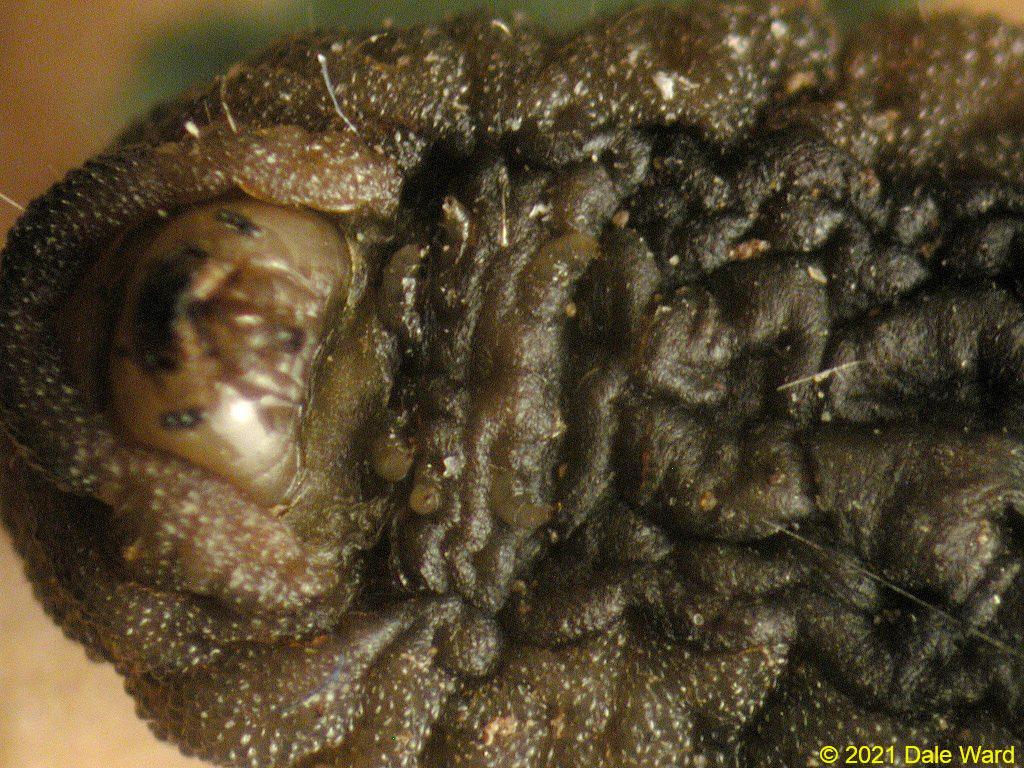 Underside of the “head end” of the larva, showing eyes (left of photo), mouth, and six thoracic legs. The larva has lost its blue color in the preservative. You can see thick collar of skin protecting the head.
Underside of the “head end” of the larva, showing eyes (left of photo), mouth, and six thoracic legs. The larva has lost its blue color in the preservative. You can see thick collar of skin protecting the head.
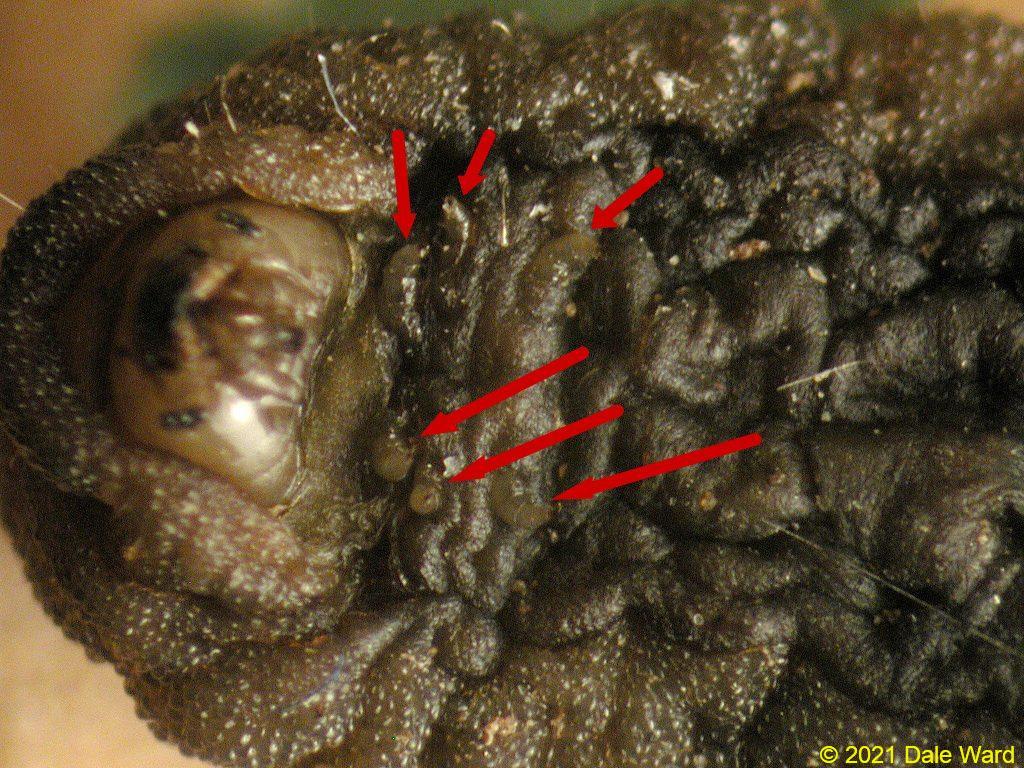 Ventral view (belly) of larva, at the “head end”. Red arrows point to the six thoracic legs.
Ventral view (belly) of larva, at the “head end”. Red arrows point to the six thoracic legs.
Strangely, the caterpillar’s prolegs - the fleshy tube-legs on the body segments after the true legs - weren’t present. Rather than having the normal prolegs - tube legs with crochet-hook claws - there was just the suggestion of prolegs.
The outline of the legs and the caterpillar segmentation reminded me of the sculpted leather abdominal muscles on the armour of Roman soldiers that one sees in movies.
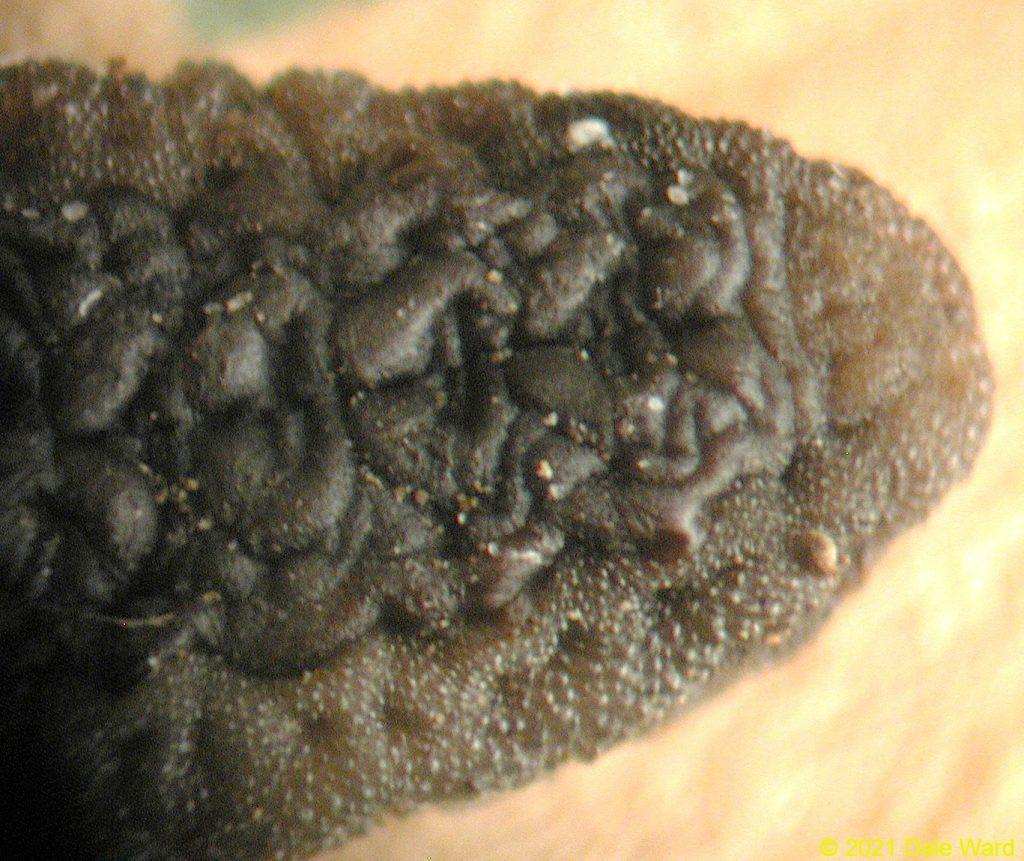 Underside of larva, tail end, showing the prolegs of the larva. They almost seem like the embossed leather on Roman legionary armour rather than legs. On most caterpillars, these prolegs are fleshy tubes with “crochet hooks” on them.
Underside of larva, tail end, showing the prolegs of the larva. They almost seem like the embossed leather on Roman legionary armour rather than legs. On most caterpillars, these prolegs are fleshy tubes with “crochet hooks” on them.
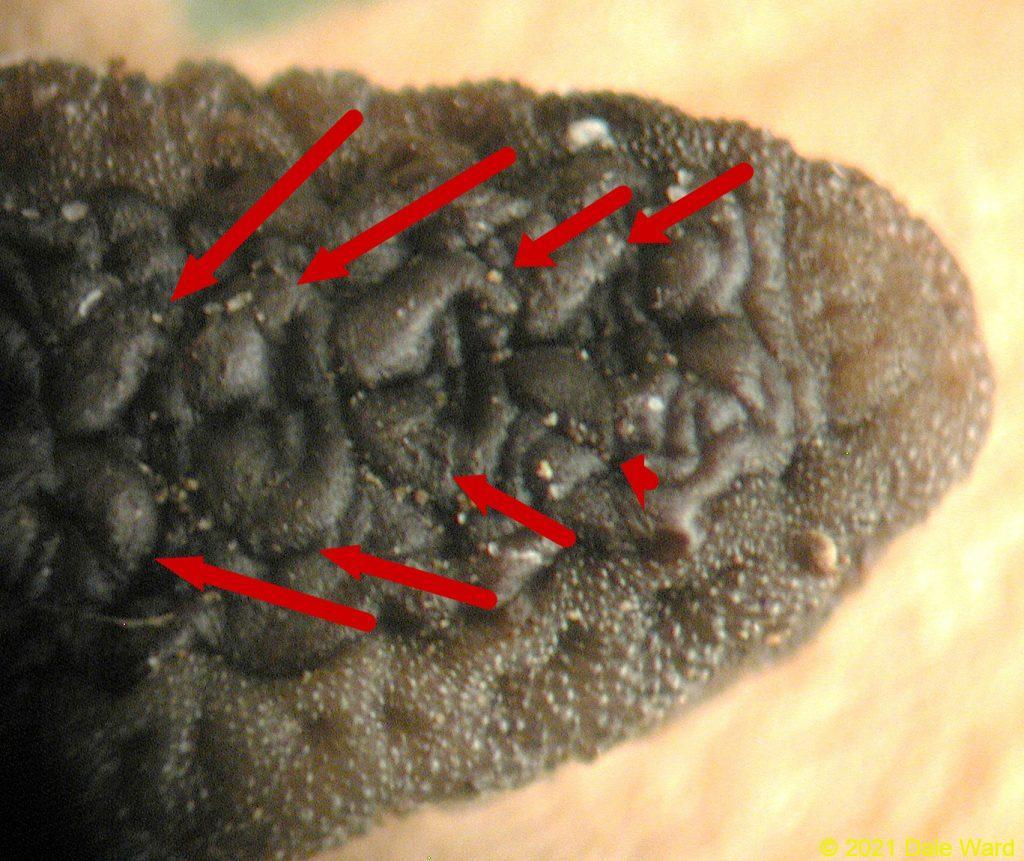 Underside of larva, tail end. Red arrows point to the prolegs of the larva. On most caterpillars, these prolegs are fleshy tubes with “crochet hooks” on them.
Underside of larva, tail end. Red arrows point to the prolegs of the larva. On most caterpillars, these prolegs are fleshy tubes with “crochet hooks” on them.
I don’t know this for sure, but my assumption is that younger versions of this caterpillar (earlier instars) had “normal” prolegs. I’m guessing that the prolegs looked this way because the caterpillar was preparing to pupate.
I researched myrmecophilous caterpillars a little more and found the outstanding papers I’ve listed below in “Sources”. It looks like this caterpillar is a Lycaenid - a member of the second-largest family of butterflies. There are around 6000 species of Lycaenid world-wide. Something like 75% of these species have an associate with ants.
I found that Diane Wagner had done a lot of work in Southeastern Arizona on an ant-associated Lycaenid butterfly - the Reakirt’s Blue Butterfly (Hemiargus isola). That’s the geographic region that I was in, as well. I think there’s a very good chance “my” caterpillars were also Hemiargus isola, or at least a closely related species.
What’s neat about the butterfly Hemiargus isola is that it prefers to lay eggs in host plants that already have ants on them. The caterpillars eat the host plant’s foliage as caterpillars normally do, but the caterpillars also bribe the ants with secretions from various specialized glands. Not only does this keep the ants from eating the caterpillars, it also convinces the ants to protect the the caterpillars from predators and parasitoids.
Jennifer Weeks (listed below) found an astonishingly high level of parasitism on H. isola caterpillars that weren’t protected by ants. Roughly 40% of the ant-protected caterpillars she looked at were parasitized by wasps or Tachinid Flies. That sounds high - but pales to the stunning 80% infection rates of non-protected caterpillars of the same species.
When the caterpillars are ready to pupate, the survivors crawl down from the host plant and enter into an ant nest. That’s the stage I found mine at.
Though I’m not sure why my ants were carrying the caterpillars. Perhaps sometimes the ants carry the caterpillars in, depending upon the ant species? Novomessor cockerelli was not listed as a host by the papers I read. Maybe they behave differently, or maybe my caterpillar is a different species than H. isola, one with a slightly different life history and relationship to its ant protectors.
Or maybe the Novomessor ants were carrying the caterpillars around in an effort to protect them from the Dorymyrmex ants that were harassing the nest.
That “protection explanation” is the one I like the best, though I have no evidence for it. It’s an appealing to me that the Novomessor ants were looking after their pet caterpillars.
After they entering the ant’s nest, the caterpillars pupate inside the nest, in relative safety from predators and parasites. The caterpillars metamorphose into butters, then emerge from their cocoons.
These newly emerged butterflies then have to frantically get out of the ant nest - they are no longer the “sugar dispensers” that the caterpillars were, and the ants evidently view them as prey.
If I’d read about this life history in a science fiction novel, I’d think it was too far-fetched. Yet that’s what happens.
What a strange world this is.
Sources:
Baylis, Matthew and Naomi E. Pierce (1993). The effects of ant mutualism on the foraging and diet of lycaenid caterpillars. In: Caterpillars: Ecological and Evolutionary Constraints on Foraging. New York: Chapman and Hall ; 1993. pp. 404-421.
Wagner, Diane and Lianne Kurina (2003). The influence of ants and water availability on oviposition behaviour and survivorship of a facultatively ant‐tended herbivore. Ecological Entomology Volume 22(3).
Weeks, Jennifer (2003). Parasitism and ant protection alter the survival of the lycaenid Hemiargus isola. Ecological Entomology. Volume 28(2) Pages 228-232. ars will often have a dorsal nectary gland (“Newcomer’s Gland”) on them that secretes a sugary substance for the ants.
I wondered if that’s what the droplet on the caterpillar in my photo was…a secretion from Newcomer’s Gland. I’d have expected the secretion to be clear, though - so perhaps the droplet of liquid was something else.
I put my preserved caterpillar under the microscope so that I could get a better look at it. Unfortunately, the caterpillar had lost its beautiful sparkly green-blue coloration after death.
 Dorsal view of caterpillar (face is down). Photograph of preserved specimen in the lab.
Dorsal view of caterpillar (face is down). Photograph of preserved specimen in the lab.
The skin of the caterpillar was tough and wrinkled, like the skin of a tiny elephant. That makes sense if one makes a habit of being carried around around in the mandibles of ants, I supposed.
I could see that the head of the caterpillar was surrounded by a collar of thick skin, like a leathery turtle-neck. The caterpillar’s body seemed to have a slight dorso-ventral curve to it, so that its head did not stick out on the front like a marshmallow on a stick, as do the heads of most caterpillars. Its face would be mostly inaccessible to the ants if the caterpillar were on a branch because of the collar and the caterpillar’s head posture.
 Photographic of a caterpillar back at the lab. Head is on the right-hand side of the photo, caterpillar is on its back. The caterpillar has lost its bluish-green color.
Photographic of a caterpillar back at the lab. Head is on the right-hand side of the photo, caterpillar is on its back. The caterpillar has lost its bluish-green color.
The caterpillar had six true legs (see two photos below).
 Underside of the “head end” of the larva, showing eyes (left of photo), mouth, and six thoracic legs. The larva has lost its blue color in the preservative. You can see thick collar of skin protecting the head.
Underside of the “head end” of the larva, showing eyes (left of photo), mouth, and six thoracic legs. The larva has lost its blue color in the preservative. You can see thick collar of skin protecting the head.
 Ventral view (belly) of larva, at the “head end”. Red arrows point to the six thoracic legs.
Ventral view (belly) of larva, at the “head end”. Red arrows point to the six thoracic legs.
Strangely, the caterpillar’s prolegs - the fleshy tube-legs on the body segments after the true legs - weren’t present. Rather than having the normal prolegs - tube legs with crochet-hook claws - there was just the suggestion of prolegs.
The outline of the legs and the caterpillar segmentation reminded me of the sculpted leather abdominal muscles on the armour of Roman soldiers that one sees in movies.
 Underside of larva, tail end, showing the prolegs of the larva. They almost seem like the embossed leather on Roman legionary armour rather than legs. On most caterpillars, these prolegs are fleshy tubes with “crochet hooks” on them.
Underside of larva, tail end, showing the prolegs of the larva. They almost seem like the embossed leather on Roman legionary armour rather than legs. On most caterpillars, these prolegs are fleshy tubes with “crochet hooks” on them.
 Underside of larva, tail end. Red arrows point to the prolegs of the larva. On most caterpillars, these prolegs are fleshy tubes with “crochet hooks” on them.
Underside of larva, tail end. Red arrows point to the prolegs of the larva. On most caterpillars, these prolegs are fleshy tubes with “crochet hooks” on them.
I don’t know this for sure, but my assumption is that younger versions of this caterpillar (earlier instars) had “normal” prolegs. I’m guessing that the prolegs looked this way because the caterpillar was preparing to pupate.
I researched myrmecophilous caterpillars a little more and found the outstanding papers I’ve listed below in “Sources”. It looks like this caterpillar is a Lycaenid - a member of the second-largest family of butterflies. There are around 6000 species of Lycaenid world-wide. Something like 75% of these species have an associate with ants.
I found that Diane Wagner had done a lot of work in Southeastern Arizona on an ant-associated Lycaenid butterfly - the Reakirt’s Blue Butterfly (Hemiargus isola). That’s the geographic region that I was in, as well. I think there’s a very good chance “my” caterpillars were also Hemiargus isola, or at least a closely related species.
What’s neat about the butterfly Hemiargus isola is that it prefers to lay eggs in host plants that already have ants on them. The caterpillars eat the host plant’s foliage as caterpillars normally do, but the caterpillars also bribe the ants with secretions from various specialized glands. Not only does this keep the ants from eating the caterpillars, it also convinces the ants to protect the the caterpillars from predators and parasitoids.
Jennifer Weeks (listed below) found an astonishingly high level of parasitism on H. isola caterpillars that weren’t protected by ants. Roughly 40% of the ant-protected caterpillars she looked at were parasitized by wasps or Tachinid Flies. That sounds high - but pales to the stunning 80% infection rates of non-protected caterpillars of the same species.
When the caterpillars are ready to pupate, the survivors crawl down from the host plant and enter into an ant nest. That’s the stage I found mine at.
Though I’m not sure why my ants were carrying the caterpillars. Perhaps sometimes the ants carry the caterpillars in, depending upon the ant species? Novomessor cockerelli was not listed as a host by the papers I read. Maybe they behave differently, or maybe my caterpillar is a different species than H. isola, one with a slightly different life history and relationship to its ant protectors.
Or maybe the Novomessor ants were carrying the caterpillars around in an effort to protect them from the Dorymyrmex ants that were harassing the nest.
That “protection explanation” is the one I like the best, though I have no evidence for it. It’s an appealing to me that the Novomessor ants were looking after their pet caterpillars.
After they entering the ant’s nest, the caterpillars pupate inside the nest, in relative safety from predators and parasites. The caterpillars metamorphose into butters, then emerge from their cocoons.
These newly emerged butterflies then have to frantically get out of the ant nest - they are no longer the “sugar dispensers” that the caterpillars were, and the ants evidently view them as prey.
If I’d read about this life history in a science fiction novel, I’d think it was too far-fetched. Yet that’s what happens.
What a strange world this is.
Sources:
Baylis, Matthew and Naomi E. Pierce (1993). The effects of ant mutualism on the foraging and diet of lycaenid caterpillars. In: Caterpillars: Ecological and Evolutionary Constraints on Foraging. New York: Chapman and Hall ; 1993. pp. 404-421.
Wagner, Diane and Lianne Kurina (2003). The influence of ants and water availability on oviposition behaviour and survivorship of a facultatively ant‐tended herbivore. Ecological Entomology Volume 22(3).
Weeks, Jennifer (2003). Parasitism and ant protection alter the survival of the lycaenid Hemiargus isola. Ecological Entomology. Volume 28(2) Pages 228-232.